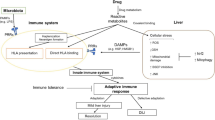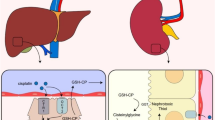Abstract
Application of omics-based technologies is a widely used approach in research aiming to improve testing strategies for human health risk assessment. In most of these studies, however, temporal variations in gene expression caused by the circadian clock are a commonly neglected pitfall. In the present study, we investigated the impact of the circadian clock on the response of the hepatic transcriptome after exposure of mice to the chemotherapeutic agent cyclophosphamide (CP). Analysis of the data without considering clock progression revealed common responses in terms of regulated pathways between light and dark phase exposure, including DNA damage, oxidative stress, and a general immune response. The overall response, however, was stronger in mice exposed during the day. Use of time-matched controls, thereby eliminating non-CP-responsive circadian clock-controlled genes, showed that this difference in response was actually even more pronounced: CP-related responses were only identified in mice exposed during the day. Only minor differences were found in acute toxicity pathways, namely lymphocyte counts and kidney weights, indicating that gene expression is subject to time of day effects. This study is the first to highlight the impact of the circadian clock on the identification of toxic responses by omics approaches.




Similar content being viewed by others
References
Akhtar RA, Reddy AB, Maywood ES et al (2002) Circadian cycling of the mouse liver transcriptome, as revealed by cDNA microarray, is driven by the suprachiasmatic nucleus. Curr Biol CB 12(7):540–550
Anton E (1993) Differential sensitivity of DBA/2 and C57BL/6 mice to cyclophosphamide. J Appl Toxicol JAT 13(6):423–427
Balsalobre A, Damiola F, Schibler U (1998) A serum shock induces circadian gene expression in mammalian tissue culture cells. Cell 93(6):929–937
Blumenthal RD, Waskewich C, Goldenberg DM, Lew W, Flefleh C, Burton J (2001) Chronotherapy and chronotoxicity of the cyclooxygenase-2 inhibitor, celecoxib, in athymic mice bearing human breast cancer xenografts. Clin Cancer Res 7(10):3178–3185
Bozek K, Relogio A, Kielbasa SM et al (2009) Regulation of clock-controlled genes in mammals. PLoS ONE 4(3):e4882. doi:10.1371/journal.pone.0004882
Colvin OM (1999) An overview of cyclophosphamide development and clinical applications. Curr Pharm Des 5(8):555–560
Cui X, Hwang JT, Qiu J, Blades NJ, Churchill GA (2005) Improved statistical tests for differential gene expression by shrinking variance components estimates. Biostatistics 6(1):59–75. doi:10.1093/biostatistics/kxh018
de Leeuw WC, Rauwerda H, Jonker MJ, Breit TM (2008) Salvaging Affymetrix probes after probe-level re-annotation. BMC Res Notes 1:66. doi:10.1186/1756-0500-1-661756-0500-1-66
DeLeve LD (1996) Cellular target of cyclophosphamide toxicity in the murine liver: role of glutathione and site of metabolic activation. Hepatology 24(4):830–837. doi:10.1002/hep.510240414
Destici E, Oklejewicz M, Nijman R, Tamanini F, van der Horst GT (2009) Impact of the circadian clock on in vitro genotoxic risk assessment assays. Mutat Res 680(1–2):87–94. doi:10.1016/j.mrgentox.2009.09.001
Emadi A, Jones RJ, Brodsky RA (2009) Cyclophosphamide and cancer: golden anniversary. Nat Rev Clin Oncol 6(11):638–647. doi:10.1038/nrclinonc.2009.146
Gachon F, Olela FF, Schaad O, Descombes P, Schibler U (2006) The circadian PAR-domain basic leucine zipper transcription factors DBP, TEF, and HLF modulate basal and inducible xenobiotic detoxification. Cell Metab 4(1):25–36. doi:10.1016/j.cmet.2006.04.015
Gorbacheva VY, Kondratov RV, Zhang R et al (2005) Circadian sensitivity to the chemotherapeutic agent cyclophosphamide depends on the functional status of the CLOCK/BMAL1 transactivation complex. Proc Natl Acad Sci USA 102(9):3407–3412. doi:10.1073/pnas.0409897102
Granda TG, Filipski E, D’Attino RM et al (2001) Experimental chronotherapy of mouse mammary adenocarcinoma MA13/C with docetaxel and doxorubicin as single agents and in combination. Cancer Res 61(5):1996–2001
Grechez-Cassiau A, Rayet B, Guillaumond F, Teboul M, Delaunay F (2008) The circadian clock component BMAL1 is a critical regulator of p21WAF1/CIP1 expression and hepatocyte proliferation. J Biol Chem 283(8):4535–4542. doi:10.1074/jbc.M705576200
Hales BF (1982) Comparison of the mutagenicity and teratogenicity of cyclophosphamide and its active metabolites, 4-hydroxycyclophosphamide, phosphoramide mustard, and acrolein. Cancer Res 42(8):3016–3021
Hill DL, Laster WR Jr, Struck RF (1972) Enzymatic metabolism of cyclophosphamide and nicotine and production of a toxic cyclophosphamide metabolite. Cancer Res 32(4):658–665
Hughes ME, Hogenesch JB, Kornacker K (2010) JTK_CYCLE: an efficient nonparametric algorithm for detecting rhythmic components in genome-scale data sets. J Biol Rhythms 25(5):372–380. doi:10.1177/0748730410379711
Hussain A, Shadma W, Maksood A, Ansari SH (2013) Protective effects of Picrorhiza kurroa on cyclophosphamide-induced immunosuppression in mice. Pharmacognosy Res 5(1):30–35. doi:10.4103/0974-8490.105646
Irizarry RA, Hobbs B, Collin F et al (2003) Exploration, normalization, and summaries of high density oligonucleotide array probe level data. Biostatistics 4(2):249–264. doi:10.1093/biostatistics/4.2.2494/2/249
Kern JC, Kehrer JP (2002) Acrolein-induced cell death: a caspase-influenced decision between apoptosis and oncosis/necrosis. Chem Biol Interact 139(1):79–95
King PD, Perry MC (2001) Hepatotoxicity of chemotherapy. Oncologist 6(2):162–176
Ko CH, Takahashi JS (2006) Molecular components of the mammalian circadian clock. Hum Mol Genet 15 Spec No 2:R271-7. doi:10.1093/hmg/ddl207
Kumaki Y, Ukai-Tadenuma M, Uno KD et al (2008) Analysis and synthesis of high-amplitude Cis-elements in the mammalian circadian clock. Proc Natl Acad Sci USA 105(39):14946–14951. doi:10.1073/pnas.0802636105
Lee C, Etchegaray JP, Cagampang FR, Loudon AS, Reppert SM (2001) Posttranslational mechanisms regulate the mammalian circadian clock. Cell 107(7):855–867
Levi F, Schibler U (2007) Circadian rhythms: mechanisms and therapeutic implications. Annu Rev Pharmacol Toxicol 47:593–628. doi:10.1146/annurev.pharmtox.47.120505.105208
Levi F, Okyar A, Dulong S, Innominato PF, Clairambault J (2010) Circadian timing in cancer treatments. Annu Rev Pharmacol Toxicol 50:377–421. doi:10.1146/annurev.pharmtox.48.113006.094626
Levi F, Karaboue A, Gorden L et al (2011) Cetuximab and circadian chronomodulated chemotherapy as salvage treatment for metastatic colorectal cancer (mCRC): safety, efficacy and improved secondary surgical resectability. Cancer Chemother Pharmacol 67(2):339–348. doi:10.1007/s00280-010-1327-8
Lowrey PL, Takahashi JS (2011) Genetics of circadian rhythms in Mammalian model organisms. Adv Genet 74:175–230. doi:10.1016/B978-0-12-387690-4.00006-4
Ludeman SM (1999) The chemistry of the metabolites of cyclophosphamide. Curr Pharm Des 5(8):627–643
Lushnikova EL, Molodykh OP, Nepomnyashchikh LM, Bakulina AA, Sorokina YA (2011) Ultrastructurural picture of cyclophosphamide-induced damage to the liver. Bull Exp Biol Med 151(6):751–756
Miller BH, McDearmon EL, Panda S et al (2007) Circadian and CLOCK-controlled regulation of the mouse transcriptome and cell proliferation. Proc Natl Acad Sci USA 104(9):3342–3347. doi:10.1073/pnas.0611724104
Mohawk JA, Green CB, Takahashi JS (2012) Central and peripheral circadian clocks in mammals. Annu Rev Neurosci 35:445–462. doi:10.1146/annurev-neuro-060909-153128
Mootha VK, Lindgren CM, Eriksson KF et al (2003) PGC-1alpha-responsive genes involved in oxidative phosphorylation are coordinately downregulated in human diabetes. Nat Genet 34(3):267–273. doi:10.1038/ng1180
Mullenders J, Fabius AW, Madiredjo M, Bernards R, Beijersbergen RL (2009) A large scale shRNA barcode screen identifies the circadian clock component ARNTL as putative regulator of the p53 tumor suppressor pathway. PLoS ONE 4(3):e4798. doi:10.1371/journal.pone.0004798
OECD Test No. 474: Mammalian Erythrocyte Micronucleus Test. OECD Publishing
Ohdo S (2010) Chronopharmaceutics: pharmaceutics focused on biological rhythm. Biol Pharm Bull 33(2):159–167
Panda S, Antoch MP, Miller BH et al (2002) Coordinated transcription of key pathways in the mouse by the circadian clock. Cell 109(3):307–320
Paschos GK, Baggs JE, Hogenesch JB, FitzGerald GA (2010) The role of clock genes in pharmacology. Annu Rev Pharmacol Toxicol 50:187–214. doi:10.1146/annurev.pharmtox.010909.105621
Pizarro A, Hayer K, Lahens NF, Hogenesch JB (2013) CircaDB: a database of mammalian circadian gene expression profiles. Nucleic Acids Res 41(Database issue):D1009-13. doi:10.1093/nar/gks1161
Rehman MU, Tahir M, Ali F et al (2012) Cyclophosphamide-induced nephrotoxicity, genotoxicity, and damage in kidney genomic DNA of Swiss albino mice: the protective effect of Ellagic acid. Mol Cell Biochem 365(1–2):119–127. doi:10.1007/s11010-012-1250-x
Reppert SM, Weaver DR (2001) Molecular analysis of mammalian circadian rhythms. Annu Rev Physiol 63:647–676. doi:10.1146/annurev.physiol.63.1.64763/1/647
Reppert SM, Weaver DR (2002) Coordination of circadian timing in mammals. Nature 418(6901):935–941. doi:10.1038/nature00965
Sancar A, Lindsey-Boltz LA, Kang TH, Reardon JT, Lee JH, Ozturk N (2010) Circadian clock control of the cellular response to DNA damage. FEBS Lett 584(12):2618–2625. doi:10.1016/j.febslet.2010.03.017
Smyth GK (2004) Linear models and empirical bayes methods for assessing differential expression in microarray experiments. Stat Appl Genet Mol Biol 3(3). doi:10.2202/1544-6115.1027
Storch KF, Lipan O, Leykin I et al (2002) Extensive and divergent circadian gene expression in liver and heart. Nature 417(6884):78–83. doi:10.1038/nature744
Storey JD, Tibshirani R (2003) Statistical significance for genomewide studies. Proc Natl Acad Sci USA 100(16):9440–9445. doi:10.1073/pnas.1530509100
Subramanian A, Tamayo P, Mootha VK et al (2005) Gene set enrichment analysis: a knowledge-based approach for interpreting genome-wide expression profiles. Proc Natl Acad Sci USA 102(43):15545–15550. doi:10.1073/pnas.0506580102
Tonk EC, de Groot DM, Penninks AH et al (2010) Developmental immunotoxicity of methylmercury: the relative sensitivity of developmental and immune parameters. Toxicol Sci 117(2):325–335. doi:10.1093/toxsci/kfq223
Tripathi DN, Jena GB (2008) Ebselen attenuates cyclophosphamide-induced oxidative stress and DNA damage in mice. Free Radical Res 42(11–12):966–977. doi:10.1080/10715760802566558
Ueda HR, Chen W, Adachi A et al (2002) A transcription factor response element for gene expression during circadian night. Nature 418(6897):534–539. doi:10.1038/nature00906
Weaver DR (1998) The suprachiasmatic nucleus: a 25-year retrospective. J Biol Rhythms 13(2):100–112
Welsh DK, Takahashi JS, Kay SA (2010) Suprachiasmatic nucleus: cell autonomy and network properties. Annu Rev Physiol 72:551–577. doi:10.1146/annurev-physiol-021909-135919
Wolfinger RD, Gibson G, Wolfinger ED et al (2001) Assessing gene significance from cDNA microarray expression data via mixed models. J Comput Biol 8(6):625–637. doi:10.1089/106652701753307520
Yan J, Wang H, Liu Y, Shao C (2008) Analysis of gene regulatory networks in the mammalian circadian rhythm. PLoS Comput Biol 4(10):e1000193. doi:10.1371/journal.pcbi.1000193
Acknowledgments
The work described was carried out under auspices of the Netherlands Toxicogenomics Centre (NTC) (http://www.toxicogenomics.nl) and received financial support from the Netherlands Genomics Initiative/Netherlands Organisation for Scientific Research (NGI/NWO Grant No. 050-060-510). The authors gratefully acknowledge the assistance of Edwin Zwart and thank Liset de la Fonteyne for immunological evaluations and for performing the micronucleus assay.
Conflict of interest
The authors declare that they have no conflict of interest.
Author information
Authors and Affiliations
Corresponding authors
Additional information
Kirsten C. G. Van Dycke and Romana M. Nijman have equally contributed to this work.
Electronic supplementary material
Below is the link to the electronic supplementary material.
Rights and permissions
About this article
Cite this article
Van Dycke, K.C.G., Nijman, R.M., Wackers, P.F.K. et al. A day and night difference in the response of the hepatic transcriptome to cyclophosphamide treatment. Arch Toxicol 89, 221–231 (2015). https://doi.org/10.1007/s00204-014-1257-z
Received:
Accepted:
Published:
Issue Date:
DOI: https://doi.org/10.1007/s00204-014-1257-z




